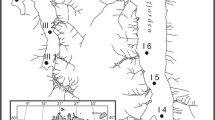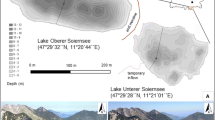Summary
The epiphytic diatoms of filamentous matforming algae in Sombre Lake, Signy Island, South Orkneys, Antarctica were examined in a field study from January to March 1987. Results reveal 1) a shallow shelf assemblage, dominated by Fragilaria spp, with high percentages of empty frustules, and low numbers of viable cells and, 2) a mid-depth zone containing the most luxuriant epiphytic growth dominated by Achnanthes minutisima Kütz., Synedra rumpens var. familiaris (Kütz) Hust., and Cymbella minuta Hilse ex Rabenh., and 3) a deep water assemblage with low numbers of actively growing cells, dominated by Stauroneis anceps var. hyalina M. Perag. et Brun. in Hérib. The comparison of methods and their impact on ecological interpretation is discussed together with a consideration of the principal factors potentially influencing community structure.
Similar content being viewed by others
References
Admiraal W, Peletier H (1979) Sulphide tolerance of benthic diatoms in relation to their distribution in an estuary. Br Phycol J 14:185–196
Björk-Ramberg S (1984) Production of epipelic algae before and during lake fertilization in a subarctic lake. Holarct Ecol 6:349–355
Cox EJ (1984) Observations on some benthic diatoms from North German lakes: the effect of substratum and light regime. Verh Int Verein Limnol 22:924–928
Cox EJ (1988) Has the role of the substratum been under-estimated for algal distribution patterns in freshwater ecosystems. Biofouling 1:49–63
Dixit SS, Evans RD (1986) Spatial variability in sedimentary algal microfossils and its bearing on diatom-inferred pH reconstruction. Can J Fish Aquat Sci 43:1836–1845
Ellis-Evans JC (1984) Methane in maritime Antarctic freshwater lakes. Polar Biol 3:63–71
Hawes I (1983) Nutrients and their effects on phytoplankton populations in lakes on Signy Island, Antarctica. Polar Biol 2:115–126
Hawes I (1985) Light climate and phytoplankton photosynthesis in maritime Antarctic lakes. Hydrobiologia 123:69–79
Hawes I (1989) Filamentous green algae in freshwater streams on Signy Island Antarctica. Hydrobiologia 172:1–18
Hendey NI (1964) An introductory account of the smaller algae of British coastal waters Part V. Bacillariophyceae diatoms. Min Ag Fish Inv, Ser 4, London
Heywood RB (1987) Limnological studies in the Antarctic Peninsula region. In: El-Sayed SZ (ed) Antarctic aquatic biology. BIOMASS Sci Ser No. 7. SCAR Cambridge, pp 157–173
Heywood RB, Dartnall HJG, Priddle J (1980) Characteristics and classification of the lakes of Signy Island, South Orkney Islands, Antarctica. Freshwater Biol 10:47–59
Jones RC, Mayer KB (1983) Seasonal changes in the taxonomic composition of epiphytic algal communities in Lake Wingra Wisconson USA. In: Wetzel RG (ed) Periphyton of freshwater ecosystems. Development in Hydrobiology. W Junk, The Hague, pp 11–16
Jørgensen BB, Marais DJ (1988) Optical properties of benthic photosynthetic communities. Fiber-optic studies of cyanobacterial mats. Limnol Oceanogr 33:99–113
Kaczmarska I, Rushforth SR (1982) Diatom associations in Blue Lake Warm Spring Tooele County, Utah, USA. In: Mann DG (ed) Proc 7th Diatom Symp, Koeltz, Koenigstein, pp 345–358
Lewis-Smith RI (1972) Vegetation of the South Orkney Islands with particular reference to Signy Island. Sci Rep Br Antarct Surv 68:124pp
Lewis-Smith RI (1988) Destruction of Antarctic terrestrial ecosystems by a rapidly increasing fur seal population. Biol Conserv 45:55–72
Losee RF, Wetzel RG (1983) Selective light attenuation by the periphyton complex. In: Wetzel RG (ed) Periphyton of freshwater ecosystems. Development in Hydrobiology. W Junk, The Hague, pp 84–96
Marker AFH, Hopgood HA, Randall CF (1986) Studies on epilithic and epiphytic diatoms in a chalkstream: comparative estimates of chlorophyll a and its derivatives. Br Phycol J 21:171–182
Moss B (1977) Adaptations of epipelic and epipsammic freshwater algae. Oecologia (Berl) 28:103–108
Priddle J (1980) The production ecology of benthic plants in some Antarctic lakes. I. In situ production studies J Ecol 68:141–153
Priddle J, Heywood RB (1980) Evolution of Antarctic lake ecosystems. Biol J Linn Soc 14:51–66
Priddle J, Hawes I, Ellis-Evans JC, Smith TJ (1986) Antarctic aquatic ecosystems as habitats for phytoplankton. Biol Rev 61:199–238
Roberts DA, Boylen CW (1988) Patterns of epipelic algal distribution in an acidic adirondack lake. J Phycol 24:146–152
Robinson GGC (1983) Methodology: the key to understanding periphyton. In: Wetzel RG (ed) Periphyton of freshwater ecosystems. Development in Hydrobiology. W Junk, The Hague, pp 245–251
Round FE (1959) The algal flora of the Tornionjoki Muonionjoki and Könkämäeno in northern Finland. Soc Sci Fenn Comment Biol 21:1–34
Round FE (1961) Studies on the bottom-living algae in some lakes of the English Lake District Part VI. The effect of depth on the epipelic community. J Ecol 49:245–254
Sorsa K (1979) Primary production of epipelic algae in Lake Suomunjärvi, Finnish North Karelia. Ann Bot Fenn 16:351–366
Stevenson RJ, Stoermer EF (1981) Quantitative differences between benthic algal communities along a depth gradient in Lake Michigan. J Phycol 17:29–36
Stockner JG, Armstrong FAJ (1971) Periphyton of the experimental lakes area, Northwestern Ontario. J Fish Res Board Can 28:215–229
Sundbäck K (1986) What are the benthic microalgae doing on the bottom of Laholm Bay. Ophelia 4:273–286
Szczepanska W (1968) Vertical distribution of periphyton in the lake Mikolajskie. Pol Arch Hydrobiol 15:177–182
Wetzel RG (1983) Littoral Communities algae and Zooplankton. In: Limnology. 2nd edn. CBS College, WB Saunders Company, pp 560–590
Author information
Authors and Affiliations
Rights and permissions
About this article
Cite this article
Oppenheim, D.R., Ellis-Evans, J.C. Depth-related changes in benthic diatom assemblages of a maritime Antarctic lake. Polar Biol 9, 525–532 (1989). https://doi.org/10.1007/BF00261037
Received:
Accepted:
Issue Date:
DOI: https://doi.org/10.1007/BF00261037




